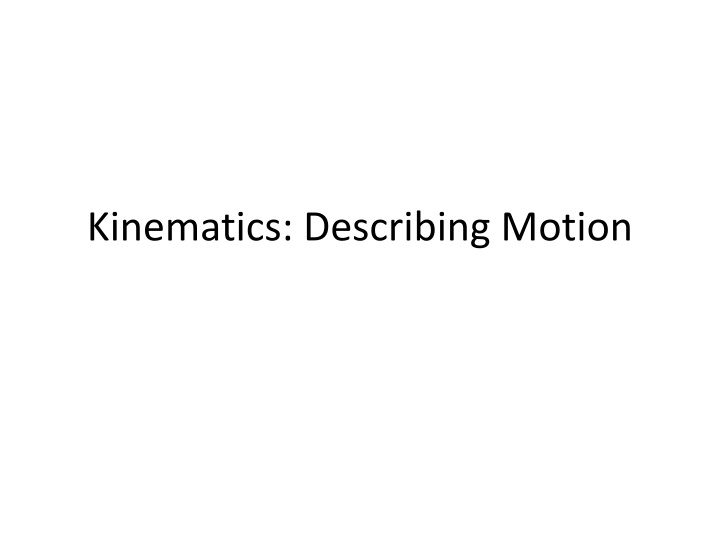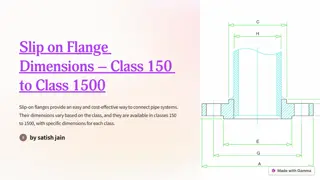
Kinematics: Describing Motion and Equations of Motion
Explore the principles of kinematics, including uniformly accelerated motion, interpreting graphs, and solving motion problems using equations. Learn about vectors, sign conventions, and analyze motion through various graph reviews. Understand the concepts of constant motion and acceleration, along with general steps for solving kinematic problems. Enhance your knowledge of position-time and velocity-time graphs in both constant and accelerated motion scenarios.
Download Presentation

Please find below an Image/Link to download the presentation.
The content on the website is provided AS IS for your information and personal use only. It may not be sold, licensed, or shared on other websites without obtaining consent from the author. If you encounter any issues during the download, it is possible that the publisher has removed the file from their server.
You are allowed to download the files provided on this website for personal or commercial use, subject to the condition that they are used lawfully. All files are the property of their respective owners.
The content on the website is provided AS IS for your information and personal use only. It may not be sold, licensed, or shared on other websites without obtaining consent from the author.
E N D
Presentation Transcript
Uniformly Accelerated Motion Interpreting graphs Equations: vinst= vo+ at x = xo+ vot + at2 vinst2 vo2= 2a x Vectors Sign conventions Sample problem
Graph Review 1 Which of the following statements most accurately describes the motion of bicycle A during the first 5 seconds? a. Bicycle A is constantly at rest. b. Bicycle A is moving with a constant speed c. Bicycle A is traveling up hill d. Bicycle A is moving in a direction opposite that of bicycle B
Graph Review 2 Which of the following statements most accurately describes the motion of bicycle B in comparison to bicycle A at t=5s? a. Bicycle B is going faster than bicycle A. b. Bicycle A is passing bicycle B. c. Bicycle B is speeding up. d. Bicycle B is moving in a direction opposite that of bicycle A.
Graph Review 3 In a position-time graph (position in cm on the y-axis and time in s on the x-axis) of a constant-motion toy car the y-intercept is -3. What is/are the unit(s) on the -3? a. cm b. cm/s c. cm/s2 d. s
Graph Review 4 In a position-time graph (position in cm on the y-axis and time in s on the x-axis) of a constant-motion toy car the y-intercept is -3. What is the physical interpretation of -3 along with its units? a. the car s position at t=3s b. the car s position at t=0s c. the car s position 3s before the clock starts d. none of these
Equations of Motion Constant Motion (a = 0) d = do+ vavet Uniformly Accelerated Motion vinst= vo+ at d = do+ vot + ( )at2 vinst2 vo2= 2a(d-do) General steps for solving simple kinematic (motion) problems: 1. Determine type of motion constant or uniformly accelerated motion. 2. Identify that for which you are looking. 3. Identify the information you have. 4. Find an appropriate relationship between all the variables in problem. 5. Solve the relationship for the unknown variable. 6. Insert quantities (including units) and solve (including units). 7. Check to see if your solution seems reasonable.
Graphs of Motion Constant Motion P-T graphs Linear Slope = velocity Area under line meaningless V-T graphs Horizontal lines Slope = acceleration Slope = 0 Area under line = displacement Do not give position Uniformly Accelerated Motion P-T graphs Curved Tangent to curve = velocity Area under curve meaningless V-T graphs Non-horizontal lines Slope = acceleration Slope does not equal 0 Area under the line = displacement Do not give position
Equation Review 1 A rock at rest is dropped from a bridge and falls 11.2m before reaching the water.The magnitude of the acceleration due to gravity is 9.81m/s2. How long does it take the rock to reach the water below? Ignore the presence of wind resistance. a. 1.14s b. 1.51s c. 2.28s d. none of these
Equation Review 2 How fast is the rock in the last question going when it hits the water? a. 11.2m/s b. 14.8m/s c. 22.4m/s d. none of these answers
Position, Distance, Displacement Position magnitude and direction (vector) from some arbitrary location. Distance A scalar quantity Measured along path traveled Displacement measures change in position. A vector quantity The straight-line distance between where one starts motion and where one ends motion.
Velocity and Speed Speed = |velocity| Instantaneous velocity versus average velocity Tangents to curved P-T graphs are instantaneous velocity. vinst= vo + at vave = (change in displacement)/(time)






















